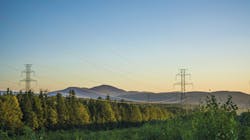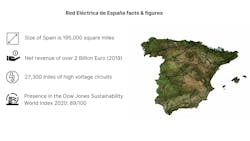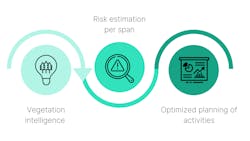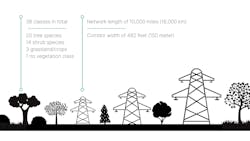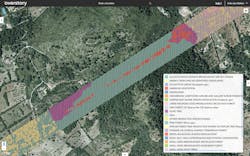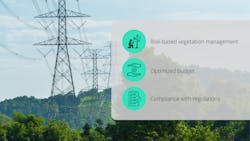Visualizing Vegetation in Spain
Vegetation management is one of the most important ways to ensure a safe and reliable transmission or distribution right-of-way (ROW) corridor. To reduce risk and optimize budgets, utilities across the globe are moving from a fixed pruning cycle to a risk-based approach. Electrical and environmental regulations are an important input for each utility when implementing a risk-based approach, and these regulations differ by country and by state. For Spanish transmission system operator (TSO) Red Eléctrica de España (REE), knowing the vegetation species is key for managing risk and compliance.
The woodlands and ecosystems on the Iberian Peninsula and nearby Islands are highly diverse in vegetation types and growth rates. This posed a challenge for REE in creating an up-to-date view of the species that grow next to their power lines. REE has been working together with the satellite and artificial intelligence company Overstory to monitor 37 different tree species, shrub species and grass classes over 10,000 miles on and around their transmission ROW.
The goal of the collaboration has been to provide a detailed and efficient vegetation map that can be used by applications and algorithms developed internally by REE to carry out vegetation management based on:
- A risk-based approach to pruning and cutting.
- A budget optimization that increases the impact of every euro spent by ensuring a focus on the riskiest areas.
- Compliance with the electrical and environmental regulations in each area of Spain.
REE is one of the first electric utilities to implement this detailed vegetation species intelligence into their operations. Detailed vegetation intelligence allows REE to have actual, updated information on the level of risk in each area and to dedicate our budget more intensively in the areas with the highest level of risk.
Multidisciplinary Collaboration
REE is the sole TSO of the Spanish electricity system. It is responsible for operating and maintaining more than 27,340 miles (44,000 km) of high-voltage circuits connecting more than 6,000 high voltage substation bays. Its technology partner is Overstory, a Europe- and U.S.-based company that provides vegetation management intelligence at scale, by combining satellite data and machine learning.
REE selected a multidisciplinary team and a technology partner. In selecting a partner for species identification, the company was looking for proven experience with solving this challenge with other customers with high precision, extensive technical abilities and alignment on approach, planning and affordability.
Knowing the Tree Species to Understand Risk
Like many utilities, REE prefers to spend its vegetation management budget in the most efficient, targeted way possible. Doing so requires detailed vegetation monitoring. Knowing the tree and shrub species that grow near their lines is critical for understanding risks and for prioritizing money and time spent around those risks. With detailed species information, REE can understand where the immediate risks are and where they will be in four years.
Different types of vegetation pose a different threat to the network because each species has a different growth rate. Species with higher growth rates should be pruned more often and vice versa. In Spain, regulation dictates what types of trees and shrubs are allowed in the ROW. As a result, species information is critical for ensuring compliance. The challenge is being able to map and distinguish between 37 different vegetation species, including 20 tree species, 14 shrub species, three grassland classes and one class that was called “no vegetation.”
In the past, it has been challenging to properly label or annotate all the species near the ROW. Other monitoring technologies such as LiDAR have not been able to provide this information. Before the collaboration with Overstory, the vegetation had to be mapped manually. This was costly to achieve the necessary level of precision and granularity.
The main barrier preventing REE from digitally identifying all vegetation species in the corridors was the high cost of the previously used method: manual photo interpretation. The high costs of manual interpretation made the business case unbearable, until REE discovered Overstory’s approach based on machine learning and satellite data.
In addition, mapping the tree species by hand meant having a snapshot for only one moment in time. Vegetation changes constantly. Trees such as Pine and Eucalyptus grow quickly in Spain. REE needed to frequently monitor species in a more scalable, cost-effective and quality-controlled way. Technology that combines satellite images and machine learning was well positioned for this challenge.
Combining Machine Learning and Satellite Data
REE is now able to monitor 37 species across all the different climate zones of Spain. In order to achieve this critical milestone, the following key requirements had to be met:
1. Accuracy: High accuracy was extremely important for REE because its vegetation management processes depend on reliable data. Algorithms had been developed and implemented to predict vegetation growth in the high-voltage corridors, and to prescribe the best actions to mitigate risks to the electrical assets. As a result, validating the reliability of the results was key.
2. Agility: Implementing an innovative solution required an agile approach and flexibility to deal with changes.
3. Affordability: A benefit calculation had been prepared by REE to ensure the business case was met and the expected budget efficiencies were realized.
At first, REE was skeptical about how the algorithms would work without any validation and recommendation from the business team, but since the first derivable, the results exceeded the initial expectations. This raised the expectations within REE about the results of the implementation.
As the project progressed, vegetation intelligence was created and validated throughout the country. Currently, the vegetation management experts have already validated the accuracy of the deliverables for all of mainland Spain and the Balearic Islands, and they’ve confirmed the accuracy exceeded expectations. The results from Overstory are currently implemented in the vegetation management cycle for 10,000 miles (16,000 km) of powerline.
The technology applied in this roll-out consists of multiple components:
- High-resolution imagery
- Machine learning methods, including convolutional neural networks
- Scalable technical pipeline
- Transparent validation and quality assurance
- Visualization
REE looked to operationalize this technology, because of its:
- Scalability and speed, because of very high-resolution imagery available across the planet for automatic
processing every day - High accuracy, because of advanced machine learning techniques, as well as structured and transparent quality control
- Affordability, compared with existing methods
Component 1: High-resolution imagery
The use of satellite imagery and aerial data was a much more scalable solution than in-the field inspection or using drones to take images. Satellite images can be acquired for any location, from any location, at any time.
Component 2: Machine learning (including convolutional neural networks)
To process these images, Overstory already had algorithms in place to identify the location of trees, shrubs, grass and urban elements like roads and buildings, and to detect certain tree species. In this case, a dataset about vegetation in Spain from REE was used to train and fine-tune the algorithms. Overstory’s existing species detection technology, combined with region-specific species data from REE, resulted in a final product that was able to label 37 different trees, shrubs and grassland species with a high degree of granularity.
Component 3: Scalable technical pipeline
Applying the models throughout Spain was possible because of a scalable technical pipeline from data acquisition, to pre-processing, extracting insights, post processing, validation and extensive quality assurance.
Component 4: Transparent validation and quality assurance
Transparent validation and quality assurance was an integral part of the roll-out. The accuracy of the output was measured at the country level, but also for each specific province. To ensure additional expertise on the Spanish landscape, partner TRAGSATEC supported the validation efforts. Vegetation characteristics of each province are different, so REE, Overstory and TRAGSATEC performed validation on each separate sub-region. The team iterated together to ensure they arrived at the best possible outcomes, and to make sure all risk and regulatory considerations were accounted for.
Component 5: Visualization
By visualizing the results, the multidisciplinary team performed additional checks and validation on the tree species. This qualitative analysis was performed after the quantitative tests and gave additional confidence in the results. Visualization also made it easy and user-friendly to take action on the data.
Optimizing Budget by a Risk-Based Pruning Approach
As a result of the collaboration, REE has a detailed and efficient-to-maintain vegetation map. The map, which is analyzed by the applications and algorithms of REE, allows REE to manage the maintenance of the vegetation, optimize the budget by focusing pruning in the areas of greatest risk and guarantee compliance with regulations in all of Spain.
Together with Overstory, REE had the capacity to adapt to any changes and challenges in this roll-out. Because Overstory works in a very agile and autonomous way, the company was able to delivering on time and with precision and quality standards required in REE’s business.
A precise and detailed view on the vegetation provides the opportunity for electric utilities to reduce risk and optimize budgets. The more detailed and granular this information is, the more relevant input it provides for a risk-based approach to pruning. Monitoring tree species on and around the right-of-way is valuable input for estimating current and future risk, and for compliance with electrical and environmental regulations.
Iago Veiras Lens is an artificial Intelligence partner with Elewit, Red Eléctrica Group. With a master’s degree in mathematics and background in data science, he has been part of the Red Eléctrica Group for more than five years. He is Artificial Intelligence Partner of Elewit, the technology platform of the Red Eléctrica Group. In his role, Veiras Lens combines his deep knowledge of data science with the expertise of the utility landscape to successfully implement innovative solutions.
Jose Manuel Avila Ollero is a high voltage line maintenance engineer for Red Eléctrica de España. He has a master’s degree in construction and maintenance of high voltage installations and an MBA from EAE Business School. He has been bringing his extensive knowledge and expertise to Red Eléctrica de España for more than 12 years. Vegetation management is one of the core responsibilities of Mr. Avila Ollero.
Anniek Schouten is COO and co-founder for Overstory. Schouten drives business growth and partnerships at Overstory. Overstory helps
utilities direct pruning efforts to areas most at risk, verify pruning work performed by third parties, support wildfire mitigation plans and make sure O&M budgets are spent in the most effective way. With a background in business strategy, Anniek founded Overstory together with machine learning experts Indra den Bakker
(background in mathematics, author of Deep Learning book) and Roelof Pieters (background in AI and previously founder of an AI company). With a team of machine learning, forestry and utility professionals, Overstory helps utilities in distribution and transmission to leverage advancements in deep learning and
satellite data for vegetation strategy.
About the Author
Iago Veiras Lens
Iago Veiras Lens is an artificial Intelligence partner with Elewit, Red Eléctrica Group. With a master’s degree in mathematics and background in data science, he has been part of the Red Eléctrica Group for more than five years. He is Artificial Intelligence Partner of Elewit, the technology platform of the Red Eléctrica Group. In his role, Veiras Lens combines his deep knowledge of data science with the expertise of the utility landscape to successfully implement innovative solutions.
Jose Manuel Avila Ollero
Jose Manuel Avila Ollero is a high voltage line maintenance engineer for Red Eléctrica de España. He has a master’s degree in construction and maintenance of high voltage installations and an MBA from EAE Business School. He has been bringing his extensive knowledge and expertise to Red Eléctrica de España for more than 12 years. Vegetation management is one of the core responsibilities of Mr. Avila Ollero.
Anniek Schouten
Anniek Schouten ([email protected]) is COO and co-founder for Overstory. Schouten drives business growth and partnerships at Overstory. Overstory helps utilities direct pruning efforts to areas most at risk, verify pruning work performed by third parties, support wildfire mitigation plans and make sure O&M budgets are spent in the most effective way. With a background in business strategy, Anniek founded Overstory together with machine learning experts Indra den Bakker (background in mathematics, author of Deep Learning book) and Roelof Pieters (background in AI and previously founder of an AI company). With a team of machine learning, forestry and utility professionals, Overstory helps utilities in distribution and transmission to leverage advancements in deep learning and satellite data for vegetation strategy.
